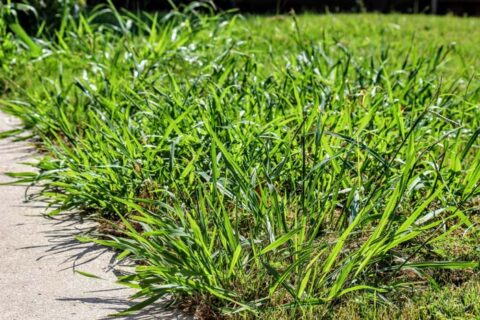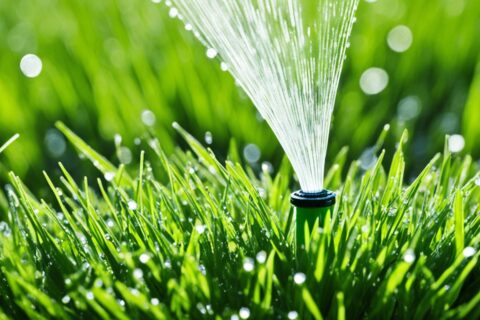Need to seed your lawn? Seed in the fall, not in the spring!

Do you want to seed your lawn but aren’t sure how? You’ve come to the right place.
Distributing seed to your property isn’t difficult – you can do it yourself with a rotary spreader. However, getting the seed to grow is often a much more arduous, stressful task – and typically not 100 percent successful – due to a number of factors, such as weather, weeds and crabgrass, soil conditions and seeding techniques (aerating success and seed distribution).
To give you a heads up, I’ll touch on a number of things you should consider when seeding your lawn.
Fall Is the Perfect (and Only) Time to Seed Lawns
Whatever you do, don’t thatch, aerate or overseed your lawn in the spring! Unfortunately, commercials from agriculture companies and even landscapers would have people believe the spring is the best time of year to perform these procedures. But that’s simply false advertising.
In the spring, emerging seedlings face an often unwinnable uphill battle for a number of reasons:
1. Weeds: Aggressive weeds grow and establish faster than young turf and therefore can suffocate it as both plant species vie for similar resources. Furthermore, it’s recommended that turf applicators wait to spray weeds in new turf for at least one month after the latter emerges – at a minimum – and ideally until the grass has been mowed at least 2 to 3 times.
2. Shallow Root System: Newgrass has a very shallow root system which means one thing: It’s going to struggle to survive summer drought and heat. Typically, people who seed lawns in the spring have to reseed them in the fall as a result.
3. Crabgrass: Crabgrass has a higher propensity to quickly establish itself in thin turf and bare areas, and it easily outcompetes new seedlings for necessary food and water. Why does this happen?
- It’s generally a more aggressive plant species.
- It can grow in and survive summer heat and drought whereas cool-season turf tends to go dormant.
- It isn’t inhibited by spring crabgrass control. Applicators absolutely can not apply crabgrass control before or immediately after seeding a lawn. The control will not only block crabgrass seeds from emerging but cool-season grass seeds as well.
The best time of year to seed large swaths of thin turf is during late summer (weather pending) and early to mid-fall when temperatures are cooler, morning dew is present, and many weeds and crabgrass are beginning to die. Less competition means seedlings have a higher chance of surviving and establishing a deep root system before the ground hardens.
Dormant Seeding and Why You Should Avoid It
I once worked at a company that offered a service they called “dormant seeding.” Basically, that involved distributing seed around the onset of winter when the ground’s either frozen or about to harden.
Why did the company offer this to its customers? It’s philosophy was that the service was a last ditch effort to grow turf for those who either forgot to seed or maybe didn’t have the chance to (new homeowners, for example). Theoretically, the seed would stay viable until the spring and then emerge when the ground thawed.
I never performed this type of seeding, but I can’t tell you how many times I saw this process fail miserably.
Let’s be honest…the company likely offered this service not because it thought it had a high chance of success but because it had the opportunity to make a few extra bucks off misinformed customers.
Don’t fall for these “shot in the dark” offerings. The window of opportunity to seed is typically late summer (weather pending) and early to mid fall. If you wait until mid-October to seed, you’re taking a risk. Unless you’re planting perennial ryegrass, which grows relatively quickly, most mixed bags of seeds (perennial rye, bluegrass and fescue) take about a month to emerge and a bit longer to establish a deep enough root system to survive the winter.
It’s critical to give your turf enough time to grow deep roots before the ground hardens. This will give it a leg up when spring arrives.
Watering Young Seed Is Crucial to Strong Turf Development
Water plays a critical role in the development of young seedlings. Without the proper amount of water, all (or most) seeds will quickly die. And when time is of the essence (as I discussed previously in regards to spring-time seeding), it’s important to seed correctly the first time around.
So what do you need to know about watering? First and foremost, always pay attention to the weather.
For example, in 2017 Massachusetts often found itself in and out of rain storms for the majority of the spring and summer – we received over 20 inches of rain during from April to mid-July. However, from July 25 to Sept. 17, the state received a mere 4.23 inches of rain with the last benefitial rain (1.05 inches) coming nearly two months prior to this post on July 25. And sure, while Mass. did receive nearly 13 inches of rain between April and June, the low rainfall total and the relatively high UV index caused many lawns to dry out. There were times I even noticed scorch marks due to high sun intensity – particularly if lawns were subjected to bursts of sunlight after prolonged cloud cover.
It’s crucial to remember that lawns are fragile ecosystems. How much you water parts of your lawn throughout the year (and even week) should change depending on rainfall totals during a given time and whether or not areas of your lawn are exposed to extensive sunlight or shade for a long time.
3 ways to tell if your lawn needs water
- Always check for signs of drought before it rains.
- Take a shovel, and press it into the ground about 6 inches. Gently push the blade forward and inspect the soil’s moisture to the turf’s root zone. The soil should appear dark and wet. Dusty or hard soil is a good indication your lawn may need more water. For a complete picture, evaluate turf situated in both sunny and shady areas, and adjust your watering habits accordingly.
- Grass blades begin to turn a dark blue/purple and eventually brown.
The Amount You Should Water Your Lawn
Water your lawn as much as it needs it! More specifically, ensure the soil is wet to the turf’s root zone.
Typically, the general rule of thumb is to make sure your lawn receives at least one inch of water per week, whether that’s from rain or sprinklers. However, this is often too broad a statement to blindly follow. For example, turf in sandy soil may need more water because the latter is prone to leaching whereas clay soil is more likely to hold water longer. Furthermore, some cool season grass types are more drought resistant than others. Varities of fescue grass, for example, are more tolerant to heat and drought because they have a deep root system.
Growing seed isn’t impossible if you take the necessary steps and show a considerable amount of patience. Remember, lawns are fragile ecosystems that can quickly react (sometimes poorly) to changing weather conditions. That’s why the best time to seed is in the fall when most weather and temperature patterns begin to stabilize, and weeds and crabgrass are less of a threat for resource and space consumption.
We service many towns in Norfolk County, Mass. including Foxborough, Mansfield, Sharon, Walpole, Norwood, Westwood, Norfolk, Medway, Millis, Medfield, Dover, Sherborn, and surrounding towns. For more information, contact us today.
Your trusted lawn care provider and lawn pest exterminator
We Service Areas of Norfolk and Bristol County, Massachusetts Including, Foxborough, Mansfield, Wrentham, Walpole, Plainville, Franklin, Norfolk, Sharon, North Attleborough, and Parts of Attleboro, Stoughton, Canton, Norwood, Norton and Medfield. Learn more about our Complete Lawn Care program.


